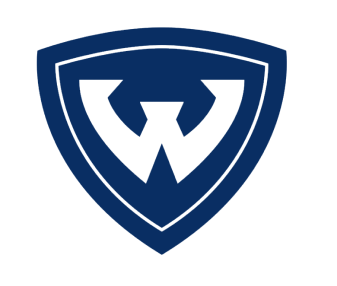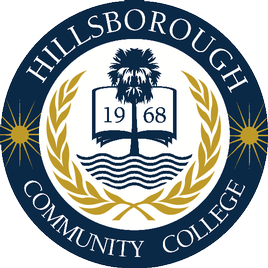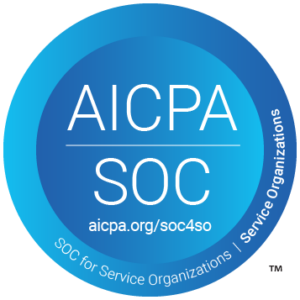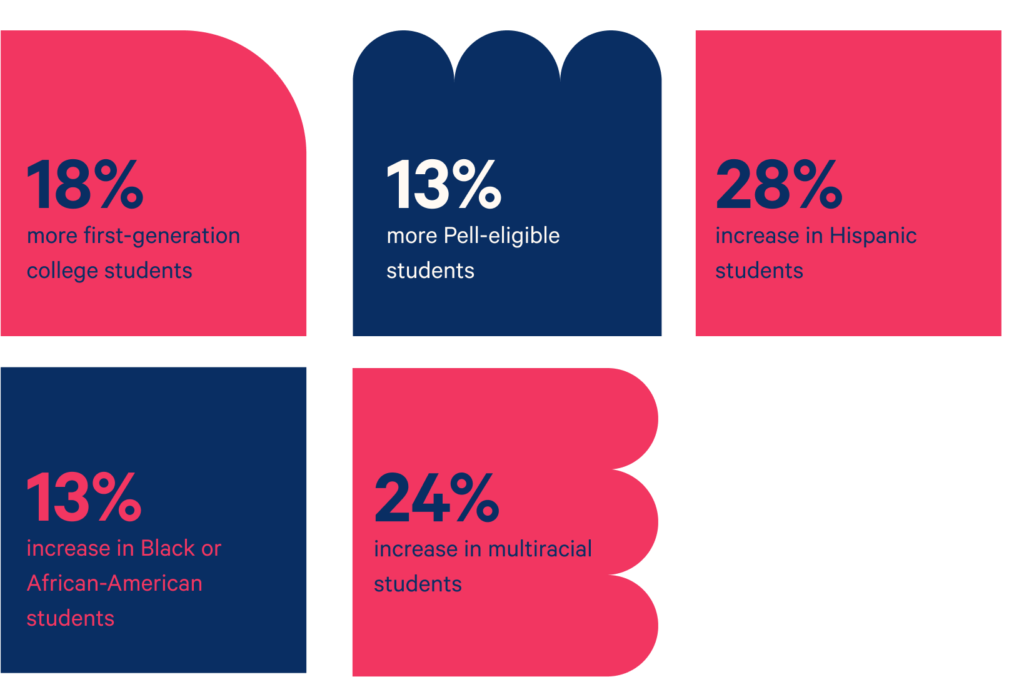
The success of Wayne State University, a large public university located in downtown Detroit, hinges heavily upon the experiences of its underserved students. After seeing graduation rates dip as low as 26%, the university knew it needed to do more to level the playing field for first-generation, low-income, and minority students. Wayne State’s committed effort to improve student success programs has transformed the university. In Fall 2018, they welcomed a record-breaking incoming class: the largest in WSU’s 150-year history. Graduation rates have nearly doubled, rising to 47% and earning the university national recognition. It’s taken a lot of hard work to achieve this incredible success.
Higher Education’s “Moral Crisis”
Wayne State’s challenges are not unique. Across the country, colleges and universities have struggled to meet the needs of underserved students. While baccalaureate degree attainment has risen in the United States, it hasn’t done so equally for all groups, according to the Council for Opportunity in Education (COE)’s research newsletter, Postsecondary Education Opportunity.
As illustrated by this chart from the American Association of State Colleges and Universities (AASCU), among the very richest Americans – those whose families are in the top quartile of income – the percentage with bachelor’s degrees by age 24 more than doubled between 1970 and 2009, from 40.2% to 82.4%. For the poorest Americans, those in the bottom income quartile, the percentage has barely changed, rising only 2.1%, from 6.2% to 8.3%.
Institutionalized Barriers to Higher Education
For Wayne State, there was only one answer: They had to find a way to make higher education more inclusive for the region’s underserved students.
Preliminary efforts at WSU included a New Student Retention Initiative to improve academic advising, the general education curriculum, faculty support, college readiness, financial aid, and the monitoring of student progress. The university also launched the Warrior Way Back Program, which forgives debt for adult learners who can’t return to college because of past-due balances.
When it came to admissions and enrollment, Medley and her team knew they couldn’t achieve their goals unless they removed the institutionalized barriers that tend to handicap underserved students throughout the college-going process. One of the biggest barriers was how they communicated with students.
Communication Challenges with Generation Z
All too often, colleges assume that simply making information publicly available is all they need to do to support students – but that’s not the case, especially for first-generation college students.
Medley compared the challenges of onboarding at college to those of renting your first apartment. “You connect with your landlord, pay your initial deposit, but then you have to turn around and you have to apply for water, gas, electric, phone, and internet,” she explained. “All of these steps involve different people, different forms to fill out in different places, and that’s really what it’s like when you get a student involved in higher ed. We think: ‘Well, everyone should be able to do that.’ But if you’ve never done it before, it can be rather daunting.”
Her team realized that having documentation posted to the website wasn’t making the process intuitive enough. Students needed more help to navigate the unfamiliar – and frequently complex – steps for admissions, enrollment, financial aid, and more.
Yet mail packets, email blasts, and phone calls weren’t the solution, particularly when it came to Gen Z students. These traditional communication channels often failed to capture their attention or meet them with where they were in the process. They also did not address the language barriers faced by many first-generation or minority students, who were unfamiliar with higher education terminology.
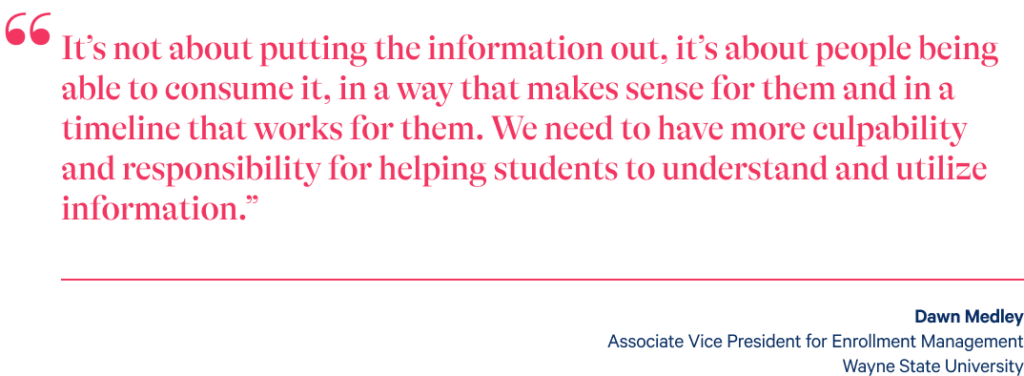
An Early Failure – and an Important Lesson
In an effort to level the playing field for underserved students, Wayne State had implemented a one-stop support center that was supposed to streamline things for incoming freshmen. The idea was that students could contact one place when they had questions for admissions, the registrar, financial aid, or billing.
However, this attempt to make service more convenient for students actually caused more problems than it solved. Staff were overwhelmed and overburdened by the quantity of inquiries. They were always behind in addressing students’ concerns, resulting in many negative reviews.
“It was a good idea,” Medley admitted, “it just wasn’t executed well.” Part of the problem was that WSU’s support systems were “all reactionary.”
The Wayne State team needed to do more to proactively support students and establish strong, personal connections with incoming freshmen. Yet in order to do so, they needed to find a way to stay in frequent contact with students while still having enough bandwidth to build those one-on-one relationships.
From Transactional to Transformational
To better serve students of all backgrounds, Wayne State had to do more than improve its transactional communications with students: it needed to focus on transforming the student experience.
“Sticking to the traditional methods of ‘we enroll, we graduate, we produce a certain type of student’ is what sinks many schools,” Medley explained.
Wayne State partnered with Mainstay to develop a new model for student support, working to blend AI-powered automation with targeted human expertise to serve students with proactive, personalized outreach more efficiently and effectively.
Knowing that text messaging was the preferred channel for most students, WSU had Mainstay create an SMS-based chatbot named “W the Warrior” – after the school’s mascot – which can answer students’ FAQs at all hours of the day or night. In addition to responding to student inquiries within seconds, the chatbot can also proactively remind applicants about upcoming deadlines, guide new students through complex processes, and connect them with the appropriate staff if necessary.

Individualized Student Support at Scale
The platform dramatically changed the way incoming freshmen could navigate the enrollment process, along with their relationship to Wayne State as a whole.
The chatbot provides a familiar and easy way for students to get support on demand, when they need it most. Plus, because W the Warrior uses conversational language, speaking as a friendly advisor or even a fellow student, it helps with the language barriers that first-generation or minority students often face. Medley explained that “students now see us as a support system, and not just the big behemoth they have to go up against.”
Beyond providing 24/7 support, the chatbot also eliminates a lot of the anxiety students felt when submitting their questions to real people. “It’s anonymous,” explained Medley. “Students don’t feel judged or feel that they’re imposters.” In her opinion, W the Warrior adds a layer of humility to higher education by offering judgment-free advice to students.
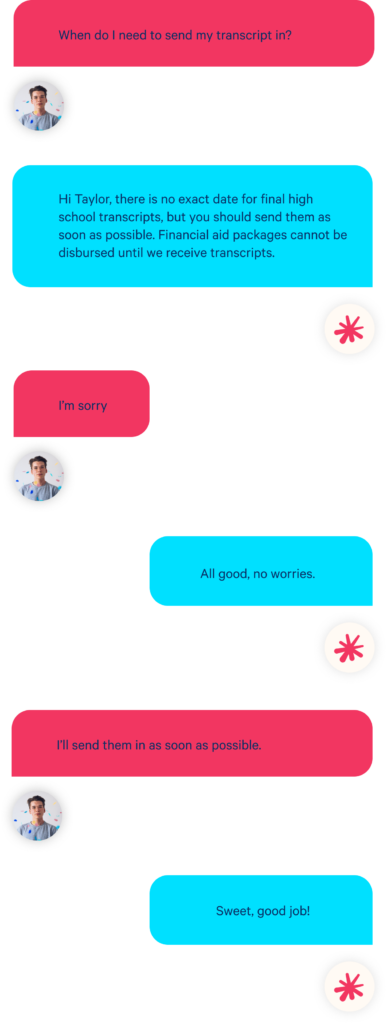
The chatbot even allows a large public university like Wayne State to offer the same kind of individual connections and support that students get at smaller private colleges. By answering the majority of students’ questions via text message, W the Warrior frees up WSU staff to have deeper conversations and build strong relationships with students. And the number of questions the chatbot can answer is continually growing, since the chatbot gets smarter with every new question that students ask.
“It comes down to Mainstay handling the majority of first questions, second questions, third questions, so that my staff can go more in depth and make the biggest impact,” shared Medley. “We need to be individually connecting with our students if we want them to be successful.”
Historic Results & Award-Winning Successes
A year after Wayne State shifted to a more student-centered support model undergirded by cutting edge technology, they yielded the largest incoming class in the university’s history. This class of 3,000 students – 14.5% more than the previous year – also shows that WSU is meeting its goal of supporting more underserved students. The Class of 2022 has 18% more first-generation college students and 13% more Pell-eligible students. It’s also more diverse, with a 28% increase in Hispanic students, a 13% increase in black or African-American students, and a 24% increase in multiracial students.
Wayne State’s other initiatives are reaping success as well. The university nearly doubled its graduation rate from 26% to 47% in just six years, which helped it win the 2018 Degree Completion Award from the Association of Pubic and Land-grant Universities (APLU).
The WSU team isn’t about to rest on their laurels, however. Thanks to the collaborative nature of Mainstay’s network of partners, they know there is so much more their chatbot can do to support student success. The university plans to extend the Mainstay platform to support current students on their path to graduation. They expect engagement with the bot to only increase over time, as students can build on the relationships they established during the admissions process.
“It’s been great for us to see how Mainstay is working with peer institutions,” said Medley. “We’re able to see how others are using the technology too and assess how we can pull that information to mold to our own improvement goals. Someone else’s sweater won’t exactly fit us, but the scarf will.”
Beyond the Walls of Wayne State
For Medley, true success is never siloed: It is her team’s responsibility to extend these results beyond the walls of Wayne State to impact the community at large. “All the time we say, ‘faculty success is student success, and student success is faculty success’. We also talk about institutional success as being part of the region … and for too long this was separate.”
She sees many opportunities close to home. There are 690,000 adults in the Detroit Metro Area with some or no college degree and 1.4 million in the state of Michigan. “A lot of those folks are disengaged with higher education, but we don’t know where or what point,” Medley explained. “They may or may not have graduated high school, they might still need a GED, they may have earned some college credits but aren’t sure how or where to continue.”
While Wayne State is already helping nearby peer 2- and 4-year institutions develop their own versions of the Warrior Way Back debt forgiveness program to re-engage more working adults in higher education, Medley wants to widen their reach even further.
Mainstay is key for her ambitious plan to help drive regional re-engagement with higher education. Wayne State has teamed up with the mayor’s office for workforce, regional colleges, the United Way, and other groups to build another chatbot with a database of knowledge that can inform disengaged adult learners about options and next steps. The service, called “Detroit Ed 411,” operates through Facebook Messenger to provide open access to the chatbot. It is being promoted through the city of Detroit and the surrounding region as the first point of contact for educational resources.
“We think it will be a great platform for people to engage with,” Medley explained. She expects disengaged adult learners to benefit from judgment-free support much in the same way freshmen at Wayne State have, allowing them to ask hard questions on the Mainstay platform without feeling overwhelmed or ashamed. Medley hopes to replicate this model in other regions nationwide.

